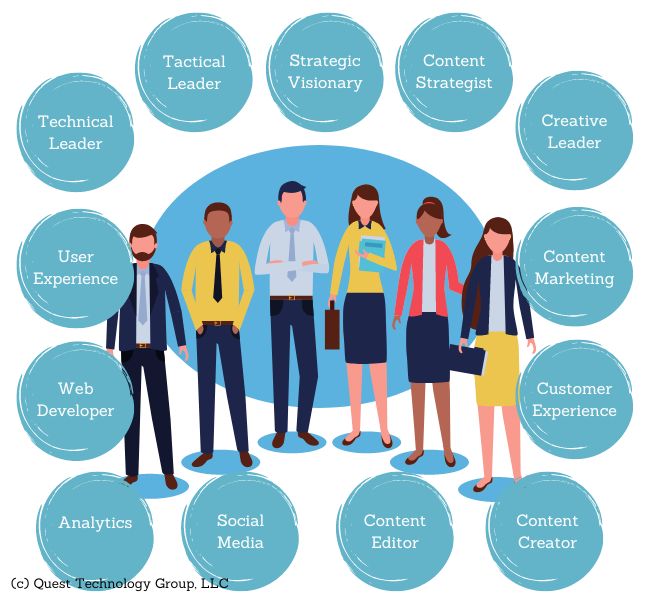How to Build Your Successful Content Marketing Team
Published by Linda Rolf on 10/9/2017 and updated 6/11/2021

It's at this point of disappointment where organizations frequently abandon their content marketing efforts. Clearly, content marketing doesn't work, right? What if there was a better way to approach to building a successful, sustainable content marketing initiative in your organization?
Content marketing with all of its promise is a relatively new addition to an organization's customer growth toolkit. As this movement continues to evolve, creating the internal content marketing team to support and nurture the changing landscape is essential. Many organizations have shoehorned content marketing activities into existing teams and silos. The result is a series of disjointed activities without the guidance of strategic vision and continuity.
Collaboration Drives Creativity
Many years ago when Quest Technology Group was launched, we started with a small team of developers. We had all worked together at a previous company, and it was easy for us to continue the cadence from that experience. As we grew we found ourselves adding more familiar team cohorts. There was a collaborative rhythm that set our pace for innovation. Each new team member brought with him or her a unique set of experiences and perspectives that contributed to our cohesive spirit.
There was that single think-like-your-customer mindset that drove everything we did. As a result we were rewarded by our customers with opportunities to explore and innovate on their behalf. None of the solutions we ultimately delivered would have come to life had it not been for a deep sense of respectful collaboration. These successful solutions were the result of joint internal team and customer creativity. Those early lessons in creative collaboration continue to drive our think-like-your-customer methods today.
Content Marketing Starts with a Content Team
To create a culture that embraces relationship-building through valuable content, the first step in launching content marketing isn't content at all but the creation of a solid team. The size of the organization might influence the number of team members, but every organization needs a cohesive content marketing team.
Start small. We've all experienced painful examples of death by committee. The purpose of the content marketing team is to ensure that the strategic vision of the organization is consistently and clearly communicated every time.
The roles outlined here all represent functions that are essential to the success of every content marketing initiative. The focus should be less on formal job titles and more on the functional contributions of each role. It's likely that one person will assume multiple roles at least at first. That's completely appropriate and fits into the "keep it small and focused" model. The main goal is to build a highly cohesive team who will collaborate, communicate and execute in harmony every time.
Strategic Visionary
Let's start at the top.
We're all familiar with Simon Sinek's Start With Why. All of the best content, tools, ideas and intentions are meaningless without a purposeful "why". The organization's CEO is the strategic visionary who creates the genuine think-like-your-customer culture throughout the organization. The organization's customer-centric purpose is continuously communicated to ensure that the content produced across all channels serves its valued customers.
Team Contributions
Content Strategist
This role title is often used interchangeably with Content Marketing Strategist. While these both are focused on content strategy, the Content Strategist operates from a broader organizational perspective. This key team member ensures consistency in all content created, produced and delivered throughout the entire organization.
In many SMB companies, the role will likely be filled by the same person. It's important to understand the differences as you set expectations for team success.
Team Contributions
Types of Content
Content Marketing Strategist
The Content Marketing Strategist is different in her content focus. She is primarily dedicated to planning and delivering meaningful content to target audiences in each buyer journey stage. She adopts the content strategist's brand and messaging framework for the organization's content initiatives.
A steady flow of valuable content is a key element to a successful content marketing strategy. As we said at the beginning of this post, it's tempting to rush to content delivery. The pipeline needs to be continuously filled with quality content and strategically planned. The content marketing strategist works closely with all team members to maintain a productive delivery plan.
Regardless of team size, there needs to be a content marketing strategist. With a team of 2 or 3, this is even more important. With a small team juggling so many roles, having a carefully designed plan can make the difference between quality content delivery and reactive noise.
Team Contributions
Types of Content
Creative Leader
This essential role is usually the CEO or CMO. He ensures the consistent quality, visual, messaging and relevance defined in the strategic vision. Every team member regardless of team size brings his and her creative talents to each project. It is important to foster individual creativity within the organization's single vision.
Team Contributions
Tactical Leader
The hands-on project leader is responsible for getting things done on time, on budget and in line with the overall strategic performance goals.
Team Contributions
Technical Leader
Regular web content updates are an integral part of the content marketing strategy. The organization's website is a living, breathing engagement tool. Quite often we see editorial calendars with the usual social media content channels planned, but the website is nowhere to be found. IT frequently exists in its own silo creating a divide between marketing and technologies that can afford real added value.
Team Contributions
Customer Experience
Customer experience (CX) is the customer's feeling about his collective interactions and relationship with a company. Customer service is often considered customer experience when in fact customer service is just one aspect of the overall experience. As customers' interactions with a company have become more complex and less predictable, the need for a customer experience program has become more critical.
While the design of an effective customer experience program is the topic for another post, customer experience leadership is a essential role in the content marketing team.
Team Contributions
User Experience
While customer experience is the collective interactions with an organization, user experience (UX) deals with customers' interactions with a web site, product or app. User experience has a direct bearing on customer experience so both are critical to overall customer satisfaction.
Team Contributions
Content Writer
It goes without saying that there can be no content marketing without writers. Creating content that clearly and effectively communicates the organization's message is a talent that might already exist within the organization. If you need to look outside the organization for writing skills, then actively include these resources in your team. Experienced writers who are willing to quickly learn and understand your organization can be valuable additions to the team.
Team Contributions
Content Editor
All content creators regardless of talent and experience benefit from the editor's review. If you do not have an experienced editor in your organization, you will likely find a resource ready to assume this role. This team member can function as an editor who has broader input into content or a copy editor who focuses on structure and wordsmithing. Regardless of the scope of duties, the important thing is to fill this role to ensure top quality content.
Team Contributions
Web Developer
Since we recognize that the organizations website is an integral part of the customer engagement strategy, the web developer is a collaborative content marketing team member. Developers often think from a largely technical perspective. Shifting that mindset to an outside in view can at times be challenging. The technical leader's role includes continuous nurturing to this attitude shift.
Team Contributions
Social Media
The ongoing growth in social media channels creates seemingly endless opportunities for customer engagement. It is all too easy to fall into the trap of trying to be in all places at one time. Unless you are a very large organization with extensive team depth, being everywhere is simply not a practical approach. Your buyer personas are your guiding star in focusing on the social media channels that are right for your organization. Don't be afraid to stay focused.
Team Contributions
SEM and Analytics
Search Engine Marketing (SEM) and Search Engine Optimization (SEO) are often used interchangeably. According to Wikipedia "Search engine marketing is a form of Internet marketing that involves the promotion of websites by increasing their visibility in search engine results pages (SERPS) through optimization and advertising." SEM includes SEO tactics, as well as several other search marketing tactics. These tactics include such things as pay-per-click (PPC) and social media marketing (SMM).
The approach selected for your organization is largely determined by your strategy, audience and where you are currently in your digital marketing presence. This is a separate discussion that we'll explore in another detailed post. For our purposes here it's important to consider how this role contributes to the content marketing initiatives.
Team Contributions
What's Next
If you've gotten to the end of this post, you may be thinking "Way too complicated. We should just get on with publishing content and see what happens." Here's how you can get started building a content marketing team that is not only less complicated than it seems but also delivers a more sustainable content marketing strategy.
Start with a success mindset. "We're ready to create even more value for our customers."
Start at the top of the team member circle. Who is the strategic visionary in your organization?
The great thing about relationships with people outside your walls is their unique perspectives and experiences. Some amazing results can be achieved through creative collaboration.
Free Resources

Build Your Content Marketing Team Template
Content Marketing One-Page Plan Template
Tags: Marketing
Download Your Free eEbook
. . .
 Linda Rolf is a lifelong curious learner. She is fueled by discovering the unexpected connections among technology, data, information, people and process. For more than four decades, Linda and Quest Technology Group have been their clients' trusted advisor and strategic partner. They actively contribute to each client's success through mutual collaboration, thoughtful business analysis, enterprise software development, technology integration, database design and management, opportunity discovery, business growth strategy, and marketing initiatives.
Linda Rolf is a lifelong curious learner. She is fueled by discovering the unexpected connections among technology, data, information, people and process. For more than four decades, Linda and Quest Technology Group have been their clients' trusted advisor and strategic partner. They actively contribute to each client's success through mutual collaboration, thoughtful business analysis, enterprise software development, technology integration, database design and management, opportunity discovery, business growth strategy, and marketing initiatives.They believe that lasting value and trust are created through continuously listening, sharing knowledge freely and delivering more than their clients even know they need. As the CIO of their first startup client said, "The value that Quest brings to Cotton States is far greater than the software they develop."

